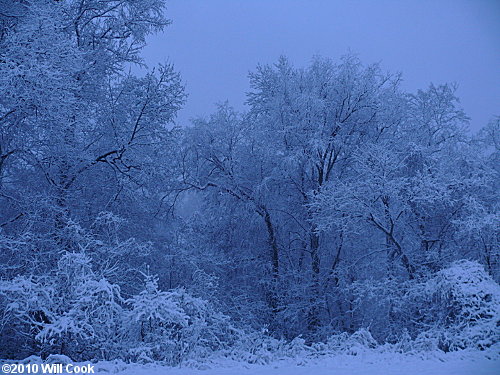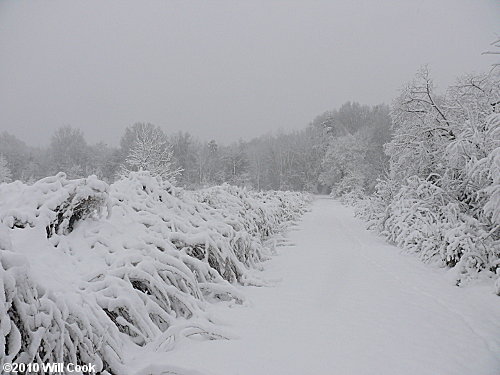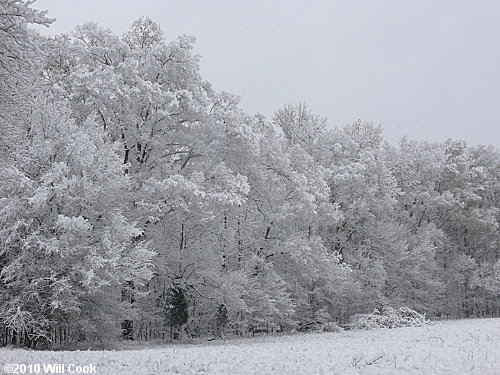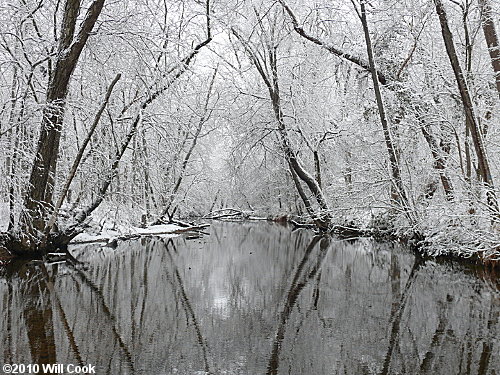
The gloom just after dawn (7:22 am) made the snow at Mason Farm seem blue.

The main trail at Mason Farm.

Sparrows buried under the snow had food and shelter — no need to show themselves.

Frosted trees.

Looking upstream from the ford at Morgan Creek.
Scenes from the snowiest Chapel Hill CBC ever!  The gloom just after dawn (7:22 am) made the snow at Mason Farm seem blue.  The main trail at Mason Farm.  Sparrows buried under the snow had food and shelter — no need to show themselves.  Frosted trees.  Looking upstream from the ford at Morgan Creek. |
The Chapel Hill Christmas Bird Count on Sunday, 26 December 2010 was definitely one for the record books. Not the number of species or individual birds, but for being the snowiest, prettiest, and siskiniest Chapel Hill count ever. Heavy snow began falling late the night before the count and by daybreak everything — ground, roads, trees, shrubbery, grasses — was covered by a spectacularly beautiful 5" thick layer of white. The snow continued off and on most of the day and eventually totalled about 6". Because of the snow many counters played it safe and stayed home; those that lived in the count circle counted their feeder birds. Most of those that ventured out found that the roads in Chapel Hill mostly weren't all that slick, just snowy, and enjoyed the most beautiful count day ever. Just 19 intrepid observers made it out in the snow, our lowest since 1971. Conversely, the 19 feeder watchers is a record high.
So how did we do with the birds? As you might guess, the weather did have a big impact on the count. We ended up with 80 species, just one shy of last year's 81, but about 10 below the 10-year average and our lowest since 1997. Not too bad, especially considering that the most productive areas at Jordan Lake went uncovered. We counted a paltry 6234 birds, less than half the 10-year average of 15978 and our lowest total since 1968. This has mostly to do with the low number of party-hours, but also the fact that it was difficult to actually see the birds in all that snow! With snow covering every limb of every tree, perched birds were lost from sight as soon as they landed. Sparrows and other field birds mostly stayed hidden in the low vegetation, under the snow. Walking through snowy fields at Mason Farm, it was bizarre to have sparrows popping out from underfoot! Number of birds per party-hour, which takes into account the low turnout, was 93.7, well below the 10-year average of 112. Also keeping birds per party-hour down, no big flocks of blackbirds, robins, or gulls were found.
The highlight of this count was an adult Bald Eagle and two Common Ravens that Derb Carter spotted feeding on a deer carcass in the snow on the side of Dairyland Road. This seems more like something you'd see in Alaska, not Chapel Hill! Besides being an amazing display of nature in the raw, this is our third count record of Common Raven, seen also in 2006 and 2007. All these were from the western edge of the count circle, though ravens have now made it much further east, to Raleigh and even to the Coastal Plain. Derb also had some Fish Crows in downtown Chapel Hill in the days before the count, for a first count week record. Other good finds on count day included an American Black Duck and Black Duck x Mallard hybrid at Mason Farm (Will Cook), a Green-winged Teal (Carter), a Blue-headed Vireo (Kent Fiala), two Red-breasted Nuthatches (Shelley Theye), a Gray Catbird (David and Judy Smith), two White-crowned Sparrows near Dairyland Road (Derb Carter), and a Baltimore Oriole at each of 3 different feeders (Judy Murray, Julia Shields, and Susan Stone). Pine Siskins are often hard to find on the count, but this year they were widespread and abundant. Total count was an astounding 357, including 150 at Cynthia Fox's feeders and 106 in Carolina Meadows.
This year we set just one record high. As you might guess — Pine Siskin! The count of 357 handily beats the 290 we had in 1969. Our average is 28; we miss them about every third count. The only other bird seen in unusually high numbers was Purple Finch — 46 is thrice the average of 15.
We set no record lows and there were no big misses, but because of the low number of field hours, dozens of species were at a small fraction of normal, at their lowest numbers in decades. Those with the lowest numbers in 40 years or more: 110 Mourning Doves (average 279, lowest since 1970), 28 Northern Flickers (average 125, lowest since 1958), 65 Blue Jays (average 248, lowest since 1964), 20 Ruby-crowned Kinglets (average 214, lowest since 1964), 51 Northern Mockingbirds (average 147, lowest since 1968), 93 European Starlings (average 716, lowest since 1958), and 50 Eastern Towhees (average 178, lowest since 1961). The count of 4 House Sparrows (average 55) is especially noteworthy since it's the lowest total since they first made an appearance on the Chapel Hill count in 1933 (no House Sparrows from the first count in 1923 through 1932).
Teams honors: Derb Carter, covering the Dairyland Road area, had the highest species count and highest individual count, with 1003 birds in 58 species. Will Cook's Mason Farm team came second in species, with 52 (797 birds).
Most abundant birds: Dark-eyed Junco (1044), White-throated Sparrow (616), American Goldfinch (405), and Pine Siskin (357).
Weather: Temperature 28-30 F, wind from the north at 5-10 mph, overcast, heavy snow in morning, light snow in afternoon, still water partly frozen, running water open. Effort: 19 observers in 10 field parties, 66.5 party hours (53.75 by foot, 12.75 by car) and 157 party miles (35.5 by foot, 121.5 by car), 2 hours and 1 miles owling, 19 people and 53 hours watching feeders.
Thanks to all the participants for slogging through the snow to count some birds!
-- Will Cook, compiler